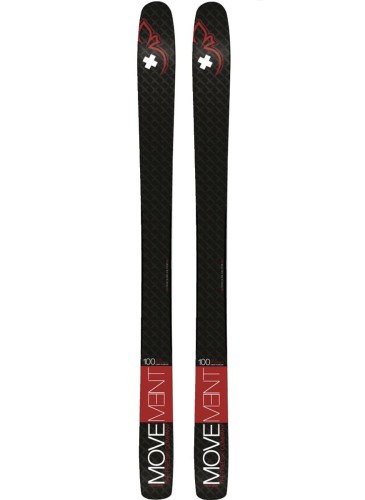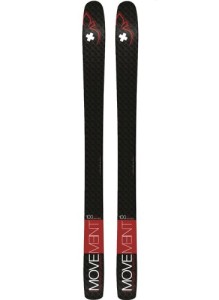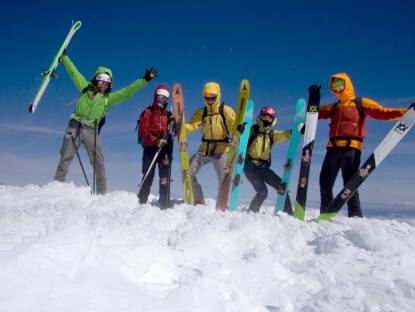Movement Alp Tracks 100 Review
Our Verdict
Our Analysis and Test Results
Product Update Note — November 2022
For the 2022/23 season, Movement quit making the Alp Tracks 100 we tested (pictured on the left.) The closest available ski is the Alp Tracks 98 (pictured right). This ski is very similar in design and size, just slightly more narrow underfoot. We suspect that the performance of the 98 is very similar to the 100, and we're now linking to the Alp Track 98 in our review.
Movement's Alp Tracks 100 is a modern classic touring ski. Its weight, dimensions, and performance are familiar and tuned for optimum human-powered efficiency and enjoyment. For all-around, all-season ski touring, this is one of our favorite skis we've tested in a while. You will pay for it with dollars and likely with some durability (light gear like this just doesn't last like heavier stuff), but you will experience great uphill and downhill performance.
Performance Comparison
Weight
We report on the weight of all our tested skis in a variety of fashions. It is common convention now to refer to a ski's weight in terms of mass of one ski, in grams. The tested pair of Alp Tracks 100, on our calibrated scale, weighs 1270g and 1272g, respectively. Just two grams separating them is really, really good. That difference could be much greater for a different selection of the same exact make and model of ski. Manufacturing variations will always leave a range of possible weights for any particular size and type of ski.
The pair of skis weighs 5.6 pounds. Further, we calculated “weight per surface area” using a simple, repeatable formula. We found this Movement product to be .62g per square centimeter. Few other skis on the market offer better weight per surface area.
No matter how you look at weight, the Alp Tracks 100 is very light. For its function and for its size, this product is an uphill-devouring dream. Equip it with tiny bindings, fast-and-light skins, and pair it with modern, high-mobility touring boots for maximum benefit.
Firm Snow
Hard, icy snow is demanding. Whether on white-out volcano crusts (see below Mount Shasta account) or spring Teton mountaineering, we were able to get a few tens of thousands of feet of ice on the Alp Tracks 100. If we were only going to ski hard snow, we wouldn't pick the Movement. This is an all-around touring ski for all seasons; there are better options for pure firm snow riding.
That being said, the Alp Tracks 100 does well enough. Our test team was comfortable on this ride everywhere that our risk tolerance allows. That is about all anyone can ask of a ski mountaineering ski. Edging is uniform fore and aft, and the edge grip is even and adequate. To say that skis grip “tenaciously” is cliche and inaccurate. We do it sometimes, but we don't like when we do.
You don't want skis to grab ice at all costs. You want even, predictable edge hold. Nonetheless, this sort of easy and lazy hyperbole pervades ski review text. Other skis will grab more securely and with even greater confidence and efficiency than the Alp Tracks. However, most of those that do better on firm snow than this ski are much heavier, perform poorer in soft snow, or both.
Powder
Oh golly! Powder snow is perfect. We have to risk gloating a little bit. Our test team hunkered down through the height of Covid restrictions with amazing Teton spring powder skiing right out the door. We got about 50,000 vertical feet of powder snow on the Alp Tracks 100. They are a blast. There is just enough float for the deepest of days, and their stiff construction belies a floating performance.
We can't call these “surfy” powder skis; the experience is more a carving, slicing sort of powder turn. Sized for efficiency and all-around performance (177cm for our 5'10", 165-pound averaged test team), the Alp Tracks 100 is bouncy and lively. They prefer medium radius turns, but an expert can readily shorten 'em up. Further, as noted above, high-speed enjoyment is possible. With perfect snow, full-throttle skiing gets you as much velocity as you should probably take on without ski patrol nearby.
Crud and Poor Snow
You are going to face “bad” snow in your backcountry skiing. This is a fact. Some patterns and regions have more than others, but every backcountry skier's day/week/season will involve tough snow of some sort. Generally, when we think of poor snow in the backcountry, we think of breakable crust and/or sloppy, heavy stuff. Every ski and every skier will, at some point, need to revert to “survival” tactics. The Alp Tracks 100 does better than most, especially considering the weight.
We assess poor snow performance while skiing poor snow. Deducing any sort of ski performance from construction and design attributes is problematic, at best. While we had piles of amazing experiences on this ski, we also got more than our share of tough stuff.
Transitional, spring “powder” skiing involves sloppy snow at the heat of the day and breakable crusts on either side. We did lots of both of these. In breakable crust, we had to apply a fair amount of “energy” to get the Alp Tracks in and out of this trap. When we did so, though, we could continue to make linked turns well past the mid-point of the aforementioned poor snow continuum. In sloppy, warm snow, the Alp Tracks feels suction-y like other relatively large touring skis but is maneuverable and consistent.
Stability at Speed
The flip side of weight, generally, is stability. Whether in steep and meticulous riding or wide-open fast shredding, you want your skis to offer a predictable and consistent platform. Attributes that lend stability in both speed and steeps are consistent; a ski stable at speed is also stable in steeps. We found, overall, the Alp Tracks 100 to be stable enough for all-around, intermediate to expert backcountry skiing and ski mountaineering.
A highlight of our Movement ski testing was a week in June on Mount Shasta in California. We had conditions that demanded stability and our lead tester pushed the Alp Tracks. First, wide-open perfect corn slopes allowed us to let 'em run. We liked what we found. We could make predictable, big, fast turns while soaking in the position and letting the gear do its job. Next, on a different day and a separate summit effort, clouds came in and shut down both visibility and softening of the spring corn snow. A few thousand of steep, zero-vis, rock-hard, tracked-and-chunky ski mountaineering taxed the team and the kit. Even solid, narrow, heavy in-bounds skis would have been maxed out in these conditions. We made the entire ski descent in good style and with dynamic (albeit slow) turns, thanks to the stability of this Movement product.
Should You Buy the Movement Alp Tracks 100?
An unqualified “yes”. Every skier, if they can afford it, has a place in their quiver for a ski like the Alp Tracks 100. It can be your only backcountry ski and serve you for 100-150 days of varied skiing. It can complement your initial, too-heavy ski setup. It can be the ski you buy for that long-coveted Alaska fly-in basecamp ski trip or the Chile early spring volcano hunting safari.
What Other Backcountry Skis Should You Consider?
Our Editors' Choice winner, the Blizzard Zero G 105 is heavier and bigger, but it skis much better. For most days of skiing, that weight is justified by the greater ski ability. The other current Editors Choice, the Atomic Backland 100, is slightly heavier than the Movement, but in our experience, skis about the same.














